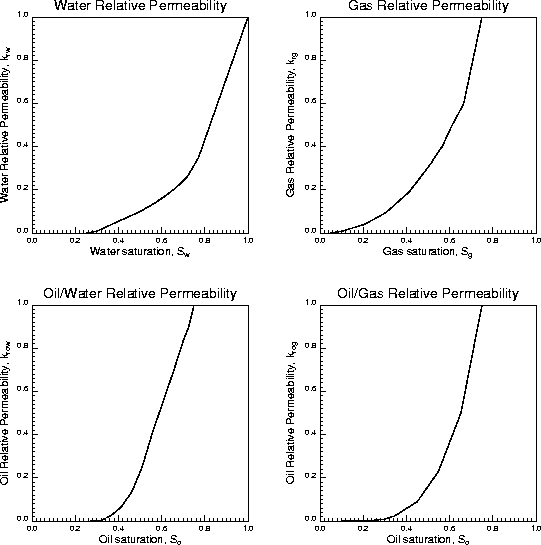




Next: Simulation
Up: Geophysics-PE: Reservoir monitoring
Previous: PVT-Properties
The effective permeability of the rock to a phase is taken as the
product of the absolute permeability times the relative permeability
of the phase which is a function of saturation.
Relative permeabilities used in the simulations are shown in
Figure ![[*]](http://sepwww.stanford.edu/latex2html/cross_ref_motif.gif) , and were taken from a North Sea data set.
Relative permeabilities for water and gas
are assumed to be a function of their own saturations only.
The oil relative permeability is calculated from two sets of oil relative
permeabilities using
, and were taken from a North Sea data set.
Relative permeabilities for water and gas
are assumed to be a function of their own saturations only.
The oil relative permeability is calculated from two sets of oil relative
permeabilities using
|  |
(2) |
where
krog is the relative permeability of oil in the presence of gas and
connate water, krow is the relative permeability of oil in presence
of water and no gas, and  and
and  are weighting functions given
by
are weighting functions given
by
|  |
(3) |
Sg is the gas saturation, Sw is the water saturation, and
Swc is the connate water saturation. This is the default model used
by Eclipse. Capillary pressure was assumed to be zero between all phases, and
phase viscosities were set constant and equal to  ,
, , and
, and  .
marcofig3
.
marcofig3
Figure 8 Relative phase permeabilities from a real North Sea data set
used for the fluid-flow simulations.






Next: Simulation
Up: Geophysics-PE: Reservoir monitoring
Previous: PVT-Properties
Stanford Exploration Project
11/12/1997
![[*]](http://sepwww.stanford.edu/latex2html/cross_ref_motif.gif) , and were taken from a North Sea data set.
Relative permeabilities for water and gas
are assumed to be a function of their own saturations only.
The oil relative permeability is calculated from two sets of oil relative
permeabilities using
, and were taken from a North Sea data set.
Relative permeabilities for water and gas
are assumed to be a function of their own saturations only.
The oil relative permeability is calculated from two sets of oil relative
permeabilities using
